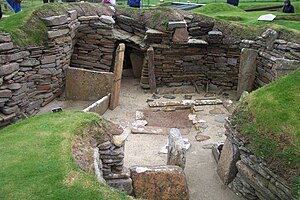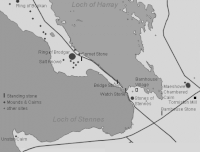Heart of Neolithic Orkney
Heart of Neolithic Orkney refers to a group of Stone Age monuments found on the Mainland, the largest of the islands of Orkney. The name was adopted by UNESCO when it proclaimed these sites as a World Heritage Site in 1999.
The sites
Four sites are included in this designation, all dated form the Neolithic Age:
- Maeshowe – a unique chambered cairn and passage grave, aligned so that its central chamber is illuminated on the winter solstice. It was looted by Norsemen, who left here one of the largest collections of runic inscriptions in the world.[1]
- Standing Stones of Stenness – the four remaining megaliths of a henge, the largest of which is 19 feet high.[2][3]
- Ring of Brodgar – a stone circle 341 feet in diameter, originally composed of 60 stones set within a circular ditch up to 10 feet deep and 30 feet wide, forming a henge monument. It has been estimated that the structure took 80,000 man-hours to construct.[4][5]
- Skara Brae – a cluster of eight houses making up Northern Europe’s best-preserved Neolithic village.[6]
The Ness of Brodgar is an archaeological site between the Ring of Brodgar and the Stones of Stenness that has provided evidence of housing, decorated stone slabs, a massive stone wall with foundations, and a large building described as a Neolithic "cathedral".[7][8] Although it is not part of the World Heritage Site, the Ness of Brodgar "contribute[s] greatly to our understanding of the WHS" according to Historic Scotland, which manages most of the site.[9]
In 2008, UNESCO expressed concern about plans by the local council to "erect three large 72 metres wind turbines to the north-west of the Stones of Stenness and the Ring of Brogdar" that might have a potential negative impact on the site.[10]
Outside links
References
- ↑ "Maeshowe". Orkneyjar. Retrieved 11 February 2008.
- ↑ "The Standing Stones o' Stenness". Orkneyjar. Retrieved 16 September 2008.
- ↑ Wickham-Jones (2007) p. 28.
- ↑ " The Ring o' Brodgar, Stenness ". Orkneyjar. Retrieved 16 September 2008.
- ↑ Wickham-Jones (2007) pp. 28–29.
- ↑ "Skara Brae Prehistoric Village" Historic Scotland. Retrieved 16 August 2009.
- ↑ Towrie, Sigurd (16 August 2007) "Stone wall hints at Neolithic spiritual barrier " Orkneyjar. Retrieved 10 September 2014.
- ↑ Ross, John and Hartley, David (14 August 2009) " 'Cathedral' as old as Stonehenge unearthed." Edinburgh. The Scotsman. Retrieved 16 August 2009.
- ↑ Heart of Neolithic Orkney - Management Plan 2014–19: Consultation Draft. Historic Scotland. 2013. p. 10. http://www.historic-scotland.gov.uk/hono-draft-management-plan.pdf.
- ↑ "Heart of Neolithic Orkney". http://whc.unesco.org/en/decisions/1725. Retrieved 30 May 2014.
- Wickham-Jones, Caroline (2007) Orkney: A Historical Guide. Edinburgh. Birlinn.
| World Heritage Sites in the United Kingdom |
|---|
|
Bath • Blaenavon Industrial Landscape • Blenheim Palace • Canterbury Cathedral, St Augustine's Abbey & St. Martin's Church • Castles and Town Walls of King Edward I • Cornwall and West Devon Mining Landscape • Derwent Valley Mills • Durham Castle & Cathedral • Edinburgh Old Town & New Town • Forth Bridge • Frontiers of the Roman Empire: Antonine Wall & Hadrian's Wall • Giant's Causeway • Ironbridge Gorge • Jurassic Coast • Kew Gardens • Liverpool Maritime Mercantile City • Maritime Greenwich • New Lanark • Heart of Neolithic Orkney • Pontcysyllte Aqueduct • St Kilda • Saltaire • Stonehenge, Avebury & Associated Sites • Studley Royal Park & Fountains Abbey • Tower of London • Palace of Westminster, Westminster Abbey & St Margaret's Church |

